Except as noted, article and photos by Joe Sapia
Note: The yard references are to my house in the section of Monroe between Helmetta and Jamesburg in South Middlesex County. My yard is in a Pine Barrens outlier on the Inner Coastal Plain, the soil is loamy, and my neighborhood is on the boundary of Gardening Zones 6b (cooler) and 7a (warmer). Notes and photographs are for the period covered, unless otherwise noted.
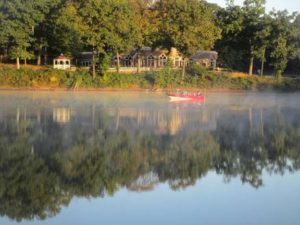
Morning on Farrington Lake, looking from East Brunswick to North Brunswick, both in Middlesex County, at the Hardenburg Lane bridge. Being on New Jersey’s Coastal Plain, where there are few, if any, natural bodies of water, Farrington Lake is created by the damming of Lawrence Brook between Davidson Mill Pond Park and Milltown.
FIRETOWERS: New Jersey’s fall wildfire season coincides with leaves falling and normally runs until about Thanksgiving and that time of year’s colder temperatures. But there could be a wildfire threat at any time if conditions are correct — and, now, we have had both falling leaves and dry conditions. So, the state Forest Fire Service is staffing its lookout towers. Visitors are welcome to go up in the towers when they are staffed – but, remember, you not only have to walk up the tower stairs, but you have to walk down. These Forest Fire Service towers are in the Jersey Midlands: Jamesburg/Middlesex County, Lakewood/Ocean County, Cedar Bridge/Ocean County, Medford/Burlington County, Lebanon/Burlington County, Apple Pie Hill/Burlington County, Batsto/Burlington County, and Bass River/Burlington County.
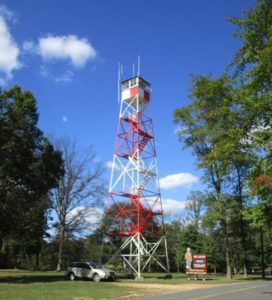
“Jamesburg Tower,” actually outside of Jamesburg in a Monroe Township section of Thompson Park, is about 65-feet-tall, sitting on high ground of about 150 feet above sea level over the Raritan River watershed.
GREAT HORNED OWL: Late at night, as I was at my desk, I thought I heard one of my favorite night sounds, the resonating hoot, hoot, hoot of a great horned owl, “Bubo virginianus.” I went outside and heard what I thought was a faint call of one, then nothing. The great horned is an early breeder, so the calling, signally both territory and looking for mates, should increase. More information, including audio of its calls, is at Cornell University’s All About Birds website, https://www.allaboutbirds.org/guide/Great_Horned_Owl/id.
BALD EAGLE, OCEAN COUNTY: Diane Larson, the home horticulturist and leader of the Master Gardeners program in Rutgers University’s Cooperative Extension Office/Monmouth County, sent in this photograph taken by her stepson, Danny Larson. It is a juvenile bald eagle, photographed on the afternoon of Thursday, October 5, on Beaver Dam Creek in Brick, Ocean County. Diane was leaning toward bald eagle, “Haliaeetus leucocephalus,” but raised a question if it could be a golden eagle, “Aquila chrysaetos.” Two New Jersey Audubon Society naturalists, Pete Bacinski (retired) and Scott Barnes (active) made the identification via this photograph. “It is a juvenile bald eagle,” Pete said. “The bill is too large for (a) golden.” “Yes, definitely a juvenile bald eagle,” Scott said. (Thank you, Danny, Diane, Pete, and Scott, for the team effort.)
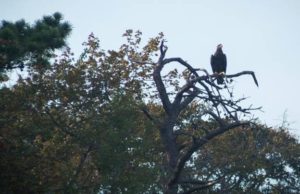
Danny Larson photographed this juvenile bald eagle on Beaver Dam Creek near his family’s house in Brick, Ocean County. (Photography copyright 2017 by Danny Larson.)
DRIVE-BY NATURALIST, DOUBLE-CRESTED CORMORANT: As I drive through the Pigeon Swamp area of South Brunswick, Middlesex County, I pass a warehouse area. There, I often see a double-crested cormorant, “Phalacrocorax auritus,” at a retention pond.

A double-crested cormorant in a retention pond in South Brunswick, Middlesex County.
STEAMING FARRINGTON LAKE: When water temperature is much warmer than air temperature, bodies of water look like steaming soup. I caught this view of Farrington Lake on a cool morning. A few winters back, when we experienced real cold temperatures, this phenomenon was seen at the Atlantic Ocean – a really cool view.
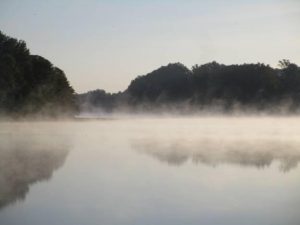
A steamy Farrington Lake, looking from East Brunswick to North Brunswick.
FALL ON THE FARMS: It is fall, so farms are displaying pumpkins and chrysanthemums. Field corn, or feed corn, awaits harvesting.
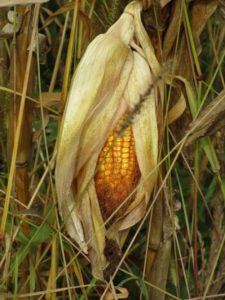
Field corn awaits harvesting in South Brunswick, Middlesex County
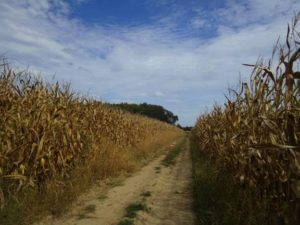
Acres of field corn await harvesting in South Brunswick
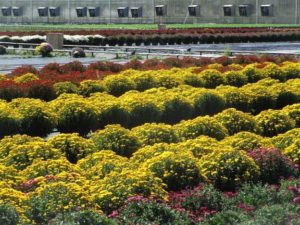
Chrysanthemums at Davino’s Nursery in East Windsor, Mercer County.
CLOUDS, NO. 1: One of the week’s beautiful clouds and sky view was from the East Windsor Community Garden in Mercer County.
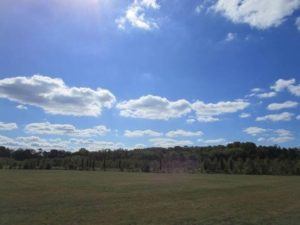
Beautiful clouds and sky view at East Windsor Community Garden in Mercer County.
CLOUDS, NO. 2: Another view of beautiful sky with clouds was from my backyard in Monroe, Middlesex County.

A clouds-in-the-sky view from my backyard in Monroe, Middlesex County.

Another clouds-in-the-sky view from my backyard.
OCEAN TEMPERATURES: Atlantic Ocean temperatures on the New Jersey coast were about 69 degrees to 71 degrees during the weekend of October 7 and 8.
SUNRISE/SUNSET: For October 8, Sunday, to October 14, Saturday, the sun will rise about 7:05 a.m. and set about 6:25 p.m. For October 15, Sunday, to October 21, Saturday, the sun will rise from about 7:10 to 7:15 a.m. and set about 6:10 to 6:15 p.m.
THE NIGHT SKY: The next full moon is the Frost Moon on the November 3-4 overnight.
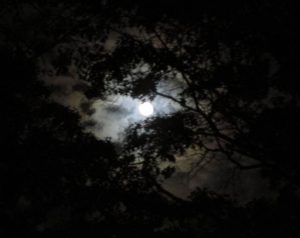
The moon over Manalapan Brook and its floodplain in Monroe, Middlesex County. This moon is waning after October 5’s Full Harvest Moon.
WEATHER: The National Weather Service forecasting station for the area is at http://www.weather.gov/phi/.

A view from Jamesburg Tower, looking south toward Monroe Township High School, from the spring of 2014.
Joe Sapia, 60, is a lifelong Monroe resident. He is a Pine Barrens naturalist and an organic vegetable-fruit gardener. He gardens the same backyard plot as did his Italian-American father, Joe Sr., and his Polish-immigrant, maternal grandmother, Annie Poznanski Onda. Both are inspirations for his food gardening. Joe is active with the Rutgers University Master Gardeners/Middlesex County program. He draws inspiration on the Pine Barrens around Helmetta from his mother, Sophie Onda Sapia, who lived her whole life in these Pines, and his Grandma Annie. Joe’s work also is at @JosephSapia on Twitter.com, along with Facebook.com on the Jersey Midlands page. Copyright 2017 by Joseph Sapia
Article and photos by Joe Mish
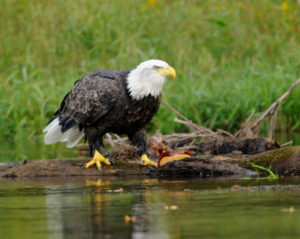
The food chain is not a one way street, as a turtle whose kin may feed on baby ducks, gets picked on by a bald eagle
It is unthinkable to imagine a restaurant where the diners are often listed as menu items. Though when seated at nature’s dinner table, the catch of the day takes on a whole new meaning as predators and prey freely alternate position. The dietary choices are also a surprise as the variety of delectable meals is often at odds with expectations.
Sorting through my library of photos, I was perplexed trying to categorize some images showing two species in close contact. Obviously notable was the reversal of who was eating who.
The first image which prompted these thoughts was captured as I launched my canoe. Here was a very young painted water snake, brilliant colored markings, with a fish sticking out its mouth. Comparing the size of the snake to the fish, I wondered if the snake ‘bit off more than he could chew’, as they say. The fish was wider than the snake and it didn’t look like much progress was being made in the attempt to swallow it. I couldn’t identify the species of fish but thought it a moment of karma as small mouth bass which inhabit the river are well known to forage on anything that swims or crawls in the waters of the south branch. A small snake would hardly be ignored by a hungry bass.
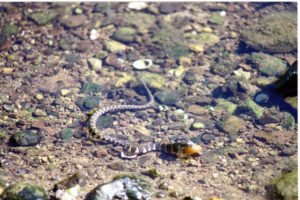
Another image shows a larger painted water snake suspended on o vertical river bank holding onto the tail of a gold colored catfish. As the snake was in an awkward position and didn’t want to go into the water, it was a standoff with the advantage going to the snake. The fish would struggle and then lay still. Eventually the fish broke free. I then remembered a series of images documenting another struggle where a snapping turtle grabbed a painted water snake by the tail. As I paddled along, I saw a water snake swimming across the river and as it neared the opposite bank it suddenly reared up and began to thrash about. Mystery solved as a snapping turtle soon surfaced holding on tight, as the snake now alternated struggling and lying still. As I drifted closer, the turtle was intimidated into releasing its grip and the snake swam off.
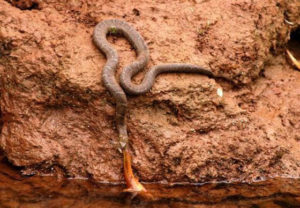
A painted water snake has a catfish by the tail. The snake is barely holding on to the vertical bank , using a tuft of grass to secure its precarious position. the catfish would struggle mighily and then rest. After several tries the catfish appeared dead and lay still for quite some time. Suddenly the catfish came to life and broke free. Again, the scene was captured from a canoe.
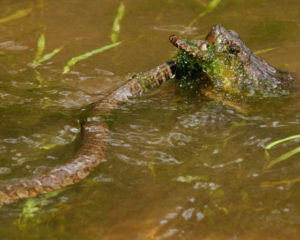
A painted water snakes has the tables turned on it as a snapping turtle reached up to grab the snake swimming across the river.
Turtles are not immune from the proverbial soup bowl as they are prey to many birds and animals that share the same habitat. Even large water snakes will easily swallow a turtle hatchling seeking cover in the water, as will great blue herons, mink, fox, skunk, raccoon and birds of prey.
In a twist of fate, the turtle that killed baby ducks in a farm pond yesterday could very well be on a larger bird’s menu today.
Such was the case when I spotted a bald eagle standing on a log near shore, intently pulling and tearing away at what was probably a deer carcass or white sucker. The eagle would occasionally look up and certainly it saw me from two hundred yards away, apparently not at all intimidated. As I closed the distance, a bright yellow object was clearly visible and the focus of the eagle’s rapt attention. I began to take photos, drifting ever closer and as I started to pass the eagle, it flew off. It was then I realized the eagle was dining on a painted turtle!
Across the land where rivers flow, the lines between predator and prey begin to blur. Don’t be surprised when a squirrel is seen carry a baby crow or a muskrat is swimming underwater holding a baby blue jay or a blue jay is flying off with a dead vole. If you can’t imagine it, it is happening somewhere along our wild rivers.
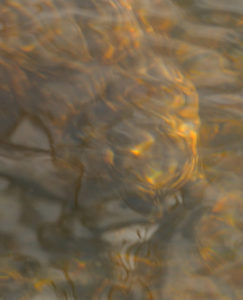
Muskrat with a bluejay swims into its den’s underwater entrance. Mystery for sure.
Author Joe Mish has been running wild in New Jersey since childhood when he found ways to escape his mother’s watchful eyes. He continues to trek the swamps, rivers and thickets seeking to share, with the residents and visitors, all of the state’s natural beauty hidden within full view. To read more of his writing and view more of his gorgeous photographs visit Winter Bear Rising, his wordpress blog. Joe’s series “Nature on the Raritan, Hidden in Plain View” runs monthly as part of the LRWP “Voices of the Watershed” series. Writing and photos used with permission from the author.
Article and photos by Joe Mish
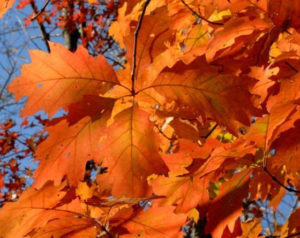
Black oak leaves are ablaze in the most incredible orange color, which makes you wonder how the black oak got its name.
A robe of many colors is October’s alone to wear. It is a coarse cloth, woven with silken threads of yellow and orange, melting into the extreme end of the red spectrum. Set against a clear blue sky, the colors radiate with brilliance. While the sun is otherwise occupied behind gathering clouds, the colors are no less extraordinary, as they hold their sharp contrast, presenting with a soft matte finish.
As the robe is placed upon the earth’s shoulders, the colors slowly flow downward in an infinitely slow progression, best seen from high above the earth. With that image in mind, it is easy to visualize autumn as a living creature leaving a momentary trail of color across the breadth of the tilting earth.
An alternative to a live, time lapsed satellite image of autumn’s gradual crawl across the latitudes, is best seen from a lofty vantage point with expansive views. Though the view is static, the full range of colors is on display. The cloth of the colorful cloak lies tight against the contour of the wooded mountains, each undulating feature of the landscape accentuated by shade and light. On a typical sunlit October day, herds of white billowy clouds drift across the blue sky followed on the ground by their shadows trying to keep up. As the lagging shadows flow across the colorful mountainsides, the tints change for a brief moment to provide a sense of movement to an otherwise still image. The scene is more dramatic if you can imagine the passing shadows being that of the artist’s hand working as you watch.
Retreating from distant views to stand within the October woodlands, individual trees and stands of trees become the focus. Each species resplendent in their own genetically defined color, modified to some degree by soil conditions, specifically, available nutrients and moisture. Instead of looking at a mass of treetops where smudges of varied colors blend together, we now see the pixels that make up the distant image.
Comparing trees of the same species, we can see the individual variation of color. Many trees with yellow leaves such as hickories, Norway maples, cherry and tulip poplar trees are very consistent in color. Oaks, sweetgum and some maples, whose leaves have a red component, show the most diversity.
The most glorious displays of fall color are where we find them, scattered among the local landscape. Each, an emissary heralding the arrival of autumn; apart from the mass of color sweeping across the land.
We all have a perennial favorite we watch on a daily basis to gauge the progress of autumn color.
A lone white oak in the middle of a field or a native red maple pressing against the chain link fence in the backyard, as seen from the bathroom window, serve as daily alerts.
Among the many autumn images accumulated in my experience, the one that keeps appearing is an old abandoned farm road lined with Norway maples, all the same size. The tree tops form a tight canopy over the road, keeping it clear of weeds and paving it with a golden carpet of fallen leaves. The length of the yellow paved road has a hint of a vanishing point that beckons a traveler to follow deeper into the fire of autumn color.
Author Joe Mish has been running wild in New Jersey since childhood when he found ways to escape his mother’s watchful eyes. He continues to trek the swamps, rivers and thickets seeking to share, with the residents and visitors, all of the state’s natural beauty hidden within full view. To read more of his writing and view more of his gorgeous photographs visit Winter Bear Rising, his wordpress blog. Joe’s series “Nature on the Raritan, Hidden in Plain View” runs monthly as part of the LRWP “Voices of the Watershed” series. Writing and photos used with permission from the author.
Article and photos by Joe Mish
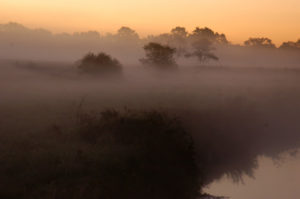 An orange sky rests upon the impenetrable white fog as dawn breaks over Holland brook on the first day of September. The predawn landscape is shrouded in a heavy mist so deep, only the treetops can be seen.
An orange sky rests upon the impenetrable white fog as dawn breaks over Holland brook on the first day of September. The predawn landscape is shrouded in a heavy mist so deep, only the treetops can be seen.
As September exhales the last warm breath of summer, it begins to inhale cool autumn air in a respiratory sequence of endless seasonal change.
With barely 9 days of autumn out of 30, the title to September is in summer’s name, despite the lien filed by fall for possession. The struggle that ensues is openly expressed in fits of alternate ownership, where autumn takes over with chilly nights while summer responds with beautiful warm days, indistinguishable from its July and August menu.
The engagement of warm summer days and cool autumn nights, in a battle for dominance, leaves the river’s flood plain covered with heavy morning mist. The impenetrable white fog hides everything except isolated tree tops to give the impression of a primordial soup that first gave rise to life on earth.
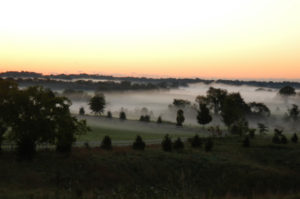
White mist rising up from the South Branch, submerges trees in a dense early morning fog, characteristic of the drastic day and night temperature changes in early fall.
As autumn appeals its case to the heavens, the sun begins to shift its position and rides lower in the sky, away from its high summer orbit. Evidence of this collusion is signaled as the dawn light colors the morning mist with every tint from gold thru orange to deep purple; a precursor to the colorful foliage that defines the fall season. The colors signal another vote for autumn’s plan to own September.
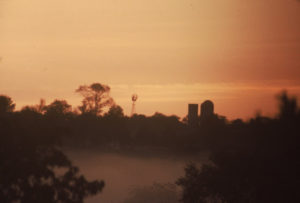
Except for the silhouette of farm building on the high ground, this scene has played out along the South Branch for thousands of years when autumn approaches.
Ultimately it is the stars in the heavens which have the final say, as they align to signal the exact moment of the autumnal equinox to find in fall’s favor. There is no chance of appeal, though summer still resists.
Offering blue skies and warm days, scraped from the bottom of it’s now empty quiver, summer attempts to keep the foliage from changing to a colorful no vote.
First to buy into autumn’s argument is Virginia creeper and poison ivy. Summer ignores their decision and counters that vines showed color back in August. A time clearly owned by summer and validated by consensus. It is when the black gum trees’ leaves began to turn a bright salmon color that summer’s brave stance began to waver. Here was a tree whose leaves began to light up the greenery like old fashioned lights tacked to the porch rail to celebrate the holiday season. Once the trees began to turn, summer knew its days were numbered.
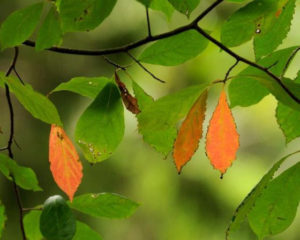
Black gum leaves mark the beginning of nature’s display of autumn color.
The stalwart oaks were the next to be counted as they sounded in favor of autumn, treating each fallen acorn as a separate vote. The deer found in favor of summer and began to eat all the fallen acorns in an attempt to cancel the oaks’ ballots. If summer was hard of hearing and the polling place rife with fraud, the oaks along with the sweet gum trees blinded the hillsides with color. Deep scarlet red oak leaves combined with a brilliant array of yellow, purple and old rose, star shaped sweet gum leaves. Norway and sugar maples chimed in with fluorescent red and yellow leaves. The final tally was overwhelming, a landslide in favor of autumn’s claim to September and an end to summer’s futile efforts to hang on.
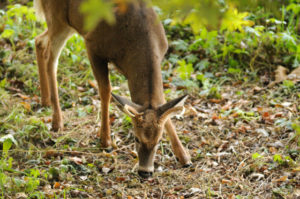
A young buck searches the ground for acorns in early September. Acorns are the number one food that deer love. when you see deer hanging around under a tree in early fall, notice that tree is more than likely an oak. Deer dine as we are supposed to, they eat what is in season.
Summer looked upon the flowers of the field to see the drooping heads and faded colors of the delicate muses it so carefully nurtured and who, in return, stood by summer’s side until their death. Summer was finally moved to surrender its claim of September to autumn. With a last warm breath, summer whispered a vow to return, even before the final days of the next spring.
Author Joe Mish has been running wild in New Jersey since childhood when he found ways to escape his mother’s watchful eyes. He continues to trek the swamps, rivers and thickets seeking to share, with the residents and visitors, all of the state’s natural beauty hidden within full view. To read more of his writing and view more of his gorgeous photographs visit Winter Bear Rising, his wordpress blog. Joe’s series “Nature on the Raritan, Hidden in Plain View” runs monthly as part of the LRWP “Voices of the Watershed” series. Writing and photos used with permission from the author.
Article and photos by Joe Sapia
Note: The yard references are to my house in the section of Monroe between Helmetta and Jamesburg in South Middlesex County. My yard is in a Pine Barrens outlier on the Inner Coastal Plain, the soil is loamy, and my neighborhood is on the boundary of Gardening Zones 6b (cooler) and 7a (warmer). Notes and photographs are for the period covered, unless otherwise noted.
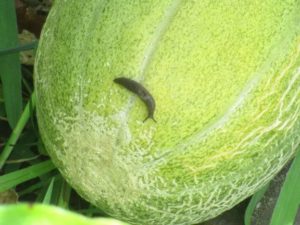
This photograph – that of a slug on a cantaloupe — basically sums up my garden’s summer fruit and vegetable crop. Slugs like moisture. And it was just a wet season.
GARDEN VOICES, NO.1: “It has simply been too wet for most things,” said Bob Eriksen, a retired biologist with the state Department of Environmental Protection who gardens in Warren County, just outside of the Jersey Midlands. “I have had groundhog issues in our garden, as well as deer. The deer are early — when the mulberries are hitting the ground, they spend time poking around our yard nibbling on everything. The groundhogs have been a major issue, eating everything from tomatoes and peppers to petunias. I have removed eight, so far, and believe there are still at least two more. I did not trap any last summer, but the summer before I caught nine.”
IN THE GARDEN: Aside from the zinnias and Knock Out roses, both of which continue to produce nicely, I pretty much have given up on the rest of the summer crop. Not one cucumber! And I fear not one cantaloupe will ripen properly. But the fall crop of carrots and lettuce, planted in early August, are coming up nicely.

Here comes the fall lettuce crop.
GARDEN VOICES, NO. 2: Paul Migut, a childhood friend and one of my gardening mentors, checked in from South River, Middlesex County. Paul, who is in his early 60s, has been food gardening since childhood: “I’d say this wasn’t the best of year for the vegetable garden. I’d say 3 out of 5.
Bush beans producing about 20 percent of previous month. Some plants drying up, branches showing signs of ‘old age’ (brown, brittle). Pickles still producing, but much slower, and also appear to be drying despite watering at 6:30am. Zucchini, a total waste as borers devoured the stalks.
Eggplants producing, but not as plump as prior years. Rutgers tomatoes small, (good color and that Jersey flavor!). Yellow (acid-free) producing fairly well, though appear a bit delicate with signs of spots, imperfections, but rather juicy. Radishes done. And the ‘mistake’ purchase of turnip (Purple Top White Globe, ‘Brassica rapa’) are still leafy, bushy, and still getting bigger — some over 4 to 5 inches diameter. Pulled more weeds than crops yesterday! Now to the house- rotate use of de-humidifier water between hydrangea in front of house and to refill backyard birdbath.” Paul is a great food gardener, making a not-so-good food garden year still a good year.

Circa late 1960s, Monroe Township – Paul Migut with an 8-horsepower roto-tiller at the huge garden of his uncle, Stanley “Pon” Ceslowski.
AROUND THE YARD: I was harvesting zinnia in the backyard garden when a large shadow passed over the backyard. I looked up and only a few yards away flew two turkey vultures, “Cathartes aura.” Usually, I see them soaring, riding the currents, rather than being nearby. I did not smell any dead animal for them to scavenge. So, perhaps they were perched nearby and I startled them.
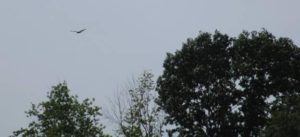
This turkey vulture flew off while I was in the backyard.
CATBIRDS AND CAT: I was doing some outside painting when a ruckus interrupted me. About four catbirds, “Dumetella carolinensis,” converged in the shrubbery behind me, next to the street. Underneath the hedges was the neighborhood cat, feasting on what was once part of the catbird clan.
DRIVE-BY NATURALIST: I was driving across the Swimming River Reservoir on the boundary of Holmdel and Colts Neck in Monmouth County and noticed two great egrets, “Ardea alba,” so I stopped and shot photos of one with Canada geese, “Branta canadensis.”
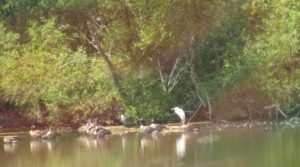
A great egret and Canada geese on the Swimming River Reservoir in Monmouth County.
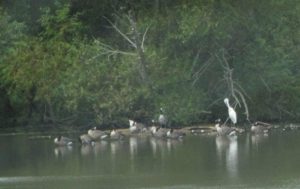
Another view of the great egret and Canada geese on the Swimming River Reservoir.
SEA BRIGHT BEACH: The Atlantic Ocean had a bit of a chop on the afternoon of Tuesday, August 29, at Sea Bright, Monmouth County, the surf tussled by the wind — sustained at about 10 to 13 knots per hour (a “gentle breeze” to “moderate breeze”) and gusts up to 14 to 19 KPH (“moderate breeze” to “fresh breeze”) about 3:30 to 4 o’clock, all out of the East Northeast, as recorded at nearby Sandy Hook. (Honestly, I thought the wind was blowing harder at Sea Bright.) Flags were extended, the surf rough, and foam, created by an agitated ocean, covered the surf line. Plus, it was raining. …But it was OK, that is what nature is about. And I had the beach to myself!
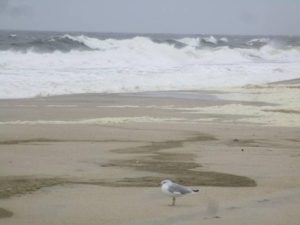
On this day at the beach in Sea Bright, Monmouth County, whitecaps were on the Atlantic Ocean, the surf churned, and the agitated ocean produced foam covering the surf line. It was kind of a day for the birds – or beach naturalists.

Flags at the Sea Bright Ocean Rescue Headquarters show the force of the wind.
SEPTEMBER AT THE SHORE: The traditional Jersey Shore summer season is the Memorial Day Weekend to the Labor Day Weekend. So, Labor Day Monday, September 4, would mean it is all over. Wrong! Remember the Shore secret, September is the best month at the Shore – less people, warm air and Atlantic Ocean temperatures, soft sunlight. But be extra careful if going into the ocean when lifeguards are not on duty.

2013, September, at the Atlantic Ocean in Asbury Park.
YELLOW FLOWERS IN THE FIELDS: The “Bidens” genus flowers are blooming nicely on unused farmland and disturbed areas. I vaguely remember hearing a story this yellow flower is not native to New Jersey, first being discovered in the state along railroad tracks at Camp Kilmer near New Brunswick in the post-World War II or Korean War years, suggesting it was transported from its native southern United States via railroad. I am going to take a guess and identify the species as “aristosa.” (But this historical and botanical information would have to be verified.) Basically, it is a weed — although a colorful one that brightens fields this time of year.
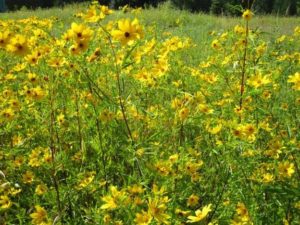
“Bidens” wildflower growing in South Brunswick, Middlesex County.
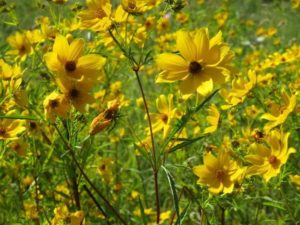
More of the “Bidens” wildflower in South Brunswick, Middlesex County.
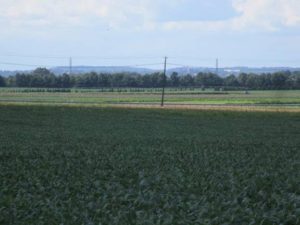
Where the generally flat Coastal Plain meets the rolling hills of the Piedmont — In the foreground is a soybean field on the boundary of Cranbury and Plainsboro in Middlesex County on the Coastal Plain, or more specifically the Inner Coastal Plain. In the distance haze are the rolling hills of Princeton, Mercer County, on the Piedmont. The Jersey Midlands are filled with stories of geology, flora, fauna, and, especially if we turn off outside lighting, the Night Sky.
COASTAL PLAIN BODIES OF WATER: Between the soybean field and the hilly ground in the previous photograph is a 23-acre pond in Plainsboro. The name on the sign, “Mill Pond Park,” says a lot. Its name suggests the pond was built, by damming Cranbury Brook, to form a power source for a mill. Most, if not all, bodies of water on the generally flat Coastal Plain are human-made.
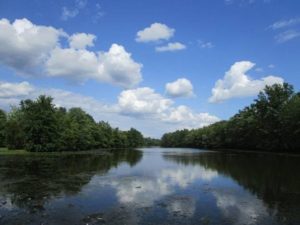
Plainsboro’s Mill Pond
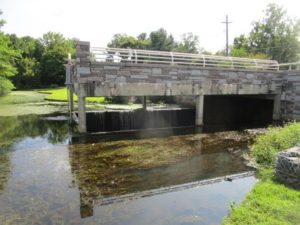
The dam that holds back Cranbury Brook to form Plainsboro’s Mill Pond.
A TALE OF TWO DEER: As I drove through Thompson Park in Monroe, I noticed a white-tail deer, “Odocoileus virginianus,” buck. He had a beautiful 10-point, velvet-covered rack. He was not free. Instead, he was confined behind a fence as part of the park zoo. Later that day, I saw another beautiful buck, this one on a section of Sourland Mountain in Montgomery, Somerset County. He roamed freely in a rural area of woods and farmland. But how free is “free”? Assuming the status of the two deer does not change, the zoo buck will be safe during hunting season, but the Sourland Mountain deer may wind up as someone’s meal or trophy.
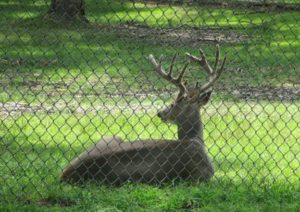
The Thompson Park Buck
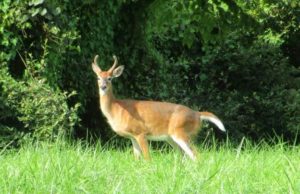
The Sourland Mountain buck.
FOR LAWN LOVERS, BLEGGGGGHHHH!: As you probably know, I dislike trophy lawns – basically, non-native wastelands filled with pollutants. Better to go green – go organic, go with native plants instead of a lawn, create high-grass wildlife patches, grow vegetables, or plant annual flowers that attract pollinators. But if you must…. Now is the correct time to seed lawns – as early in September as possible, not later than mid-September. This time of year provides for good seed growth, while competitive weeds are no longer growing. See the Rutgers University Cooperative Extension Service “Seeding Your Lawn” fact sheet, https://njaes.rutgers.edu/pubs/fs584/.
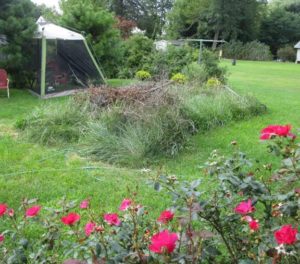
A wildlife patch in my neatly kept, but un-trophy-like, lawn.
GARDEN VOICES, NO. 3: Priscilla “Peppy” Bath, who gardens in Hamilton, Mercer County, knows about my quest to eliminate lawn in favor of garden. She checked in from vacation in Germany’s Black Forest. “I took a walk this morning and the house across from my hotel has no grass at all, just a beautifully maintained garden. It has flowers and vegetables, no weeds. Knock Out roses, cosmos, mountain pink, lots of lettuce, green beans, tomatoes, zucchini, and bare spaces where other already-harvested vegetables were. Perhaps this is what you are striving for.”
LEECHES: Sophie Onda Sapia used to tell me about leeches when she was a kid in the Pine Barrens Around Helmetta, where she lived all her 81 years, from 1913 to 1995. Ma said sometime one or more would latch onto one when swimming in the local waters. I have been around these waters all my 60 years – blessed to still walk afield where my maternal family has walked more than 100 years, despite New Jersey urbanization – and never recall pulling a leech off me. But I saw some chatter the other day on the “Jersey Pine Barrens” Facebook.com page about the “unusual amount” of leeches encountered, this year. Thoughts?
GRIGGSTOWN FARM: I stopped at Griggstown Farm near the Delaware and Raritan Canal in Franklin, Somerset County, and bought some goods – sweet corn, tomato, etc. Of course, I shot photos. More information, https://griggstownfarm.com/.

The market at Griggstown Farm in Franklin, Somerset County.

Tomatoes at Griggstown Farm.

Griggstown Farm’s cookbook library.
OCEAN TEMPERATURES: Atlantic Ocean temperatures on the New Jersey coast were in the range of about 72 to 74 degrees Thursday, August 31.
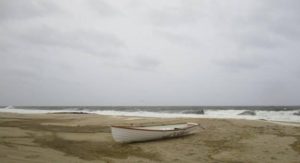
A lifeguard boat at Sea Bright, Monmouth County.
SUNRISE/SUNSET: For September 3, Sunday, to September 9, Saturday, the sun will rise about 6:30 a.m. and set about 7:20 p.m. For September 10, Sunday, to September 16, Saturday, the sun will rise about 6:35 to 6:40 a.m. and set about 7:10.
THE NIGHT SKY: The Full Corn Moon is on the Sept. 5-6, Tuesday-Wednesday, overnight.
WEATHER: The National Weather Service forecasting station for the area is at http://www.weather.gov/phi/.
UPCOMING: September 9 and 10, Saturday and Sunday, 10 a.m. to 5 p.m., the state Department of Environmental Protection’s Wild Outdoor Expo at the Colliers Mills Wildlife Management Area, Jackson, Ocean County, WildOutdoorExpo.com.

The zinnias from the garden keep on giving. Here, at a friend’s house.
Joe Sapia, 60, is a lifelong Monroe resident. He is a Pine Barrens naturalist and an organic vegetable-fruit gardener. He gardens the same backyard plot as did his Italian-American father, Joe Sr., and his Polish-immigrant, maternal grandmother, Annie Poznanski Onda. Both are inspirations for his food gardening. Joe is active with the Rutgers University Master Gardeners/Middlesex County program. He draws inspiration on the Pine Barrens around Helmetta from his mother, Sophie Onda Sapia, who lived her whole life in these Pines, and his Grandma Annie. Joe’s work also is at @JosephSapia on Twitter.com, along with Facebook.com on the Jersey Midlands page.
Article and photos by Joe Sapia
Note: The yard references are to my house in the section of Monroe between Helmetta and Jamesburg in South Middlesex County. My yard is in a Pine Barrens outlier on the Inner Coastal Plain, the soil is loamy, and my neighborhood is on the boundary of Gardening Zones 6b (cooler) and 7a (warmer). Notes and photographs are for the period covered, unless otherwise noted.
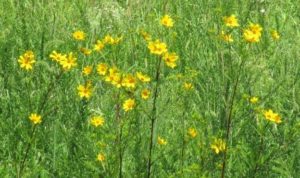
Flowers of the “Bidens” genus growing along South River Road/Route 535 in Cranbury, Middlesex County.
YELLOW FLOWERS IN FIELDS: This time of year, it is common to see a yellow flower of the “Bidens” genus on overgrown farmland. Over the last dozen years, I have seen them begin blooming from about August 20 to August 25. This year, I saw the first blooming August 24, Thursday – in this case in Cranbury, Middlesex County.
IN THE GARDEN, SWEET CORN: I wrapped up the sweet corn harvest, which produced a poor, but usable, crop. The ears developed only partially, basically one half with kernels, one half without. The poor development may be attributable to poor pollination. Corn should be planted in blocks so its pollen can fly back and forth to the plants in the wind. If pollination was the problem, I see two major reasons – one, my corn block was probably too small, in part thanks to a house re-modeling project that fouled up my garden area and by planting a bigger garden this year, I lost area to plant corn in larger blocks and, two, the wet weather may have kept down the spread of pollen. Because I like eating the corn raw off the cob or, if cooked, then sliced off with a knife, the poor development did not affect me in eating what I could harvest. But the quantity of the harvest also was terrible, meaning I had less corn to eat.
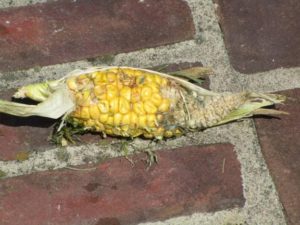
A half-developed ear of corn from the garden.
ELSEWHERE IN THE GARDEN: The early cool-weather harvest was so-so – great pickings of lettuce, carrots having a low yield, and peas bombing out. The jury is still out on the summer crop – I gave up on growing tomato plants from the seeds I planted and bought plants, only to have something eat the tops off of them; as I said, the corn generally bombed; the cucumbers bombed, probably because of too much rain, and I still have hope for mushmelon. My first-time planting of zinnias has saved the summer crop.

This may be the culprit that is eating the plants in my garden – a ground hog, “Marmota monax.” It was photographed in my next-door neighbor’s yard.
GRATEFUL FOR THE ZINNIAS: If it was not for my zinnias, planted in the food garden to attract pollinators, I would not have much of a summer harvest. Not only do the zinnias attract pollinators, but they are nice to look at – and give away.
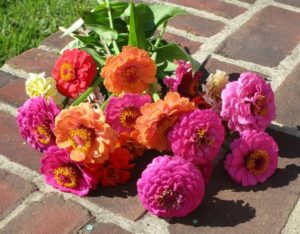
Zinnias as a gift for the eye doctor’s office.
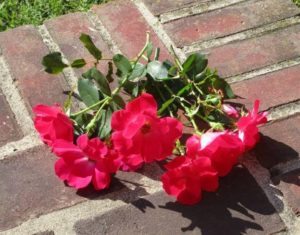
Add some Knock Out roses for the eye doctor’s office.

Zinnias, along with tomatillos, for the kitchen table.
ZINNIAS AND BUTTERFLIES: My morning zone-out time, just after getting up, would be watching the birds at the feeder. This summer, however, I gave up the feeder – saving money on top-quality (and costly) feed of corn kernels and putting the birds to work harvesting insects in the yard. So, until cool weather comes and the feeder goes back up, my only meditative exercise was watering the garden. Now, I found something new – watching the butterflies in the zinnia. I have discovered if I just go about my business of walking through the zinnia patch or harvesting zinnia, the butterflies just go about their business. They do not fly off by my intrusion. The butterflies and I have become friends. I am becoming one with the zinnia patch.
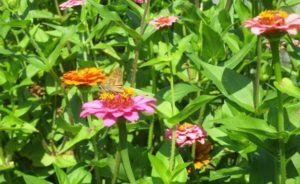
I believe the butterfly on the zinnia is a sachem, “Atalopedes campestris.”
DRAGONFLIES AROUND THE YARD: My yard seems to have hosted a lot of dragonflies this summer. Now, I have to learn to identify them.
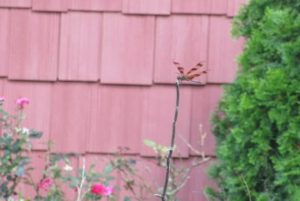
A dragonfly in my backyard.
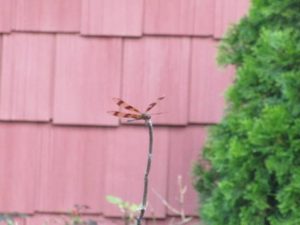
Another view of the dragonfly in my backyard.
KEYPORT HARBOR: On a free-lance writing assignment, I had to go out to the Raritan Bayshore of Monmouth County, so I stopped by Keyport harbor to crank off some photographs.
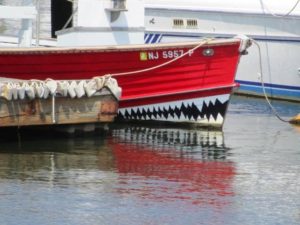 Jaws at Keyport Harbor, Monmouth County
Jaws at Keyport Harbor, Monmouth County

From Keyport harbor, looking to Staten Island, New York City, in the hazy distance.
THE ECLIPSE OF THE SUN: My plan was to stay inside during the August 21, Monday, solar eclipse, so as not to be tempted to look at the sun and possibly ruin my eyesight. Well, I was working at my desk during the eclipse, realized I left my camera in my Jeep, and went outside to retrieve it. I grabbed a kitchen strainer and, with my back to the sun, let the sunlight shine through the holes of the strainer onto my back porch. It was pretty cool, watching dozens of shadows of the sun in eclipse. With about 75 percent of the sun covered around 2:45 p.m., sun shadows were obvious, but the sunlight had the soft glow of dusk. Insects remained calling and a butterfly flew by.

The eclipse through the strainer.
BLUEBIRD SKY: While out in the yard August 24, Thursday, I noticed how clear the sky was – a “bluebird sky.” Jet airplanes could be clearly seen, with that I-almost-can-touch-them look. That means there was little moisture in the air – a dew point of only 52.
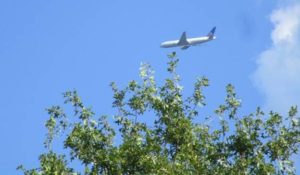
With low moisture in the air, this United Airlines flight, headed to Newark Liberty International Airport from Tel Aviv, Israel, looked very close to my backyard. It was actually flying at an estimated 3,000 feet.

Another view of the “bluebird sky” from my backyard.
DEW POINT: My go-to science guy – Joey Slezak of Helmetta, who has a bachelor’s degree in meteorology and is now working on his master’s in meteorology, both from Rutgers University – tells me dew point, not the humidity reading, is the real gauge of moisture around us and how we feel in it. Here, according to www.fredericksburg.com in Virginia, is how we feel at these dew points — under 55, pleasant; 56 to 60, comfortable; 61 to 65, getting sticky; 66 to 70, uncomfortable; 71 to 75, oppressive; more than 75, miserable.
BOBWHITE QUAIL IN NEW JERSEY: A Philadelphia Inquirer article about restoring BobWhite quail, “Colinus virginianus,” to the Pine Barrens, http://www.philly.com/philly/columnists/kevin_riordan/bringing-back-a-bird-that-once-made-a-signature-sound-of-the-pine-barrens-20170822.html. See Cornell University’s All About Birds website for more on the BobWhite, https://www.allaboutbirds.org/guide/Northern_Bobwhite/id.
CRICKETS IN MY CELLAR: As an only child, I inherited the house I grew up in and which my parents owned for almost four years before I was born in 1956. I never remember crickets in the cellar when I was a kid. But after I took over the house 15 years ago, I noticed a cricket invasion from about August until the fall weather set in. Now, a cricket-chirping cacophony is pleasant, but one or two crickets in the wee hours while one is trying to sleep is AN-NOY-ING – and it turns me from Dr. Naturalist to Mr. Killer, Serial Killer if there is more than one of these little nuisances calling away. But I just had a $38,000 re-modeling of my house, including new siding and insulation. The best $38,000 I could spend on eradicating crickets from the cellar. So far, and it is already late August, only six crickets – none of which are with us anymore. I mean, if a cricket wants to live outside and chirp away, I get it. But if a cricket wants to invade my cellar and rub those little ugly legs together, NO. (OK, OK, OK, now that I feel sort of bad about cricket killing, I will tell you about Revenge of the Crickets. A few years ago, I saw a cricket in the cellar. And I had had it! So, I picked up the pail I used to empty de-humidifier water into and SMASHED the cricket. I poured the de-humidifier water into the bucket — and the water spilled onto the cellar floor. Yes, I had cracked the bucket when I obliterated the cricket. I never learn – whenever I act surly, I pay for it.)
(Sorry, no photo of a dead cricket.)
OCEAN TEMPERATURES: Atlantic Ocean temperatures on the New Jersey coast were in the range of about 74 to 77 degrees.
SUNRISE/SUNSET: For August 27, Sunday, to September 2, Saturday, the sun will rise about 6:20 to 6:25 a.m. and set about 7:30 p.m.
WEATHER: The National Weather Service forecasting station for the area is at http://www.weather.gov/phi/.
UPCOMING: September 9 and 10, Saturday and Sunday, 10 a.m. to 5 p.m., the state Department of Environmental Protection’s Wild Outdoor Expo at the Colliers Mills Wildlife Management Area, Jackson, Ocean County, WildOutdoorExpo.com.
DOES ANYBODY ELSE…?: …Go to a fast-food restaurant and instead of tossing in the garbage all the paper packaging and so on, take it home for recycling?

Sailboats at Keyport harbor.
Joe Sapia, 60, is a lifelong Monroe resident. He is a Pine Barrens naturalist and an organic vegetable-fruit gardener. He gardens the same backyard plot as did his Italian-American father, Joe Sr., and his Polish-immigrant, maternal grandmother, Annie Poznanski Onda. Both are inspirations for his food gardening. Joe is active with the Rutgers University Master Gardeners/Middlesex County program. He draws inspiration on the Pine Barrens around Helmetta from his mother, Sophie Onda Sapia, who lived her whole life in these Pines, and his Grandma Annie. Joe’s work also is at @JosephSapia on Twitter.com, along with Facebook.com on the Jersey Midlands page. Copyright 2017 by Joseph Sapia
Article and photos by Joe Sapia
Note: The yard references are to my house in the section of Monroe between Helmetta and Jamesburg in South Middlesex County. My yard is in a Pine Barrens outlier on the Inner Coastal Plain, the soil is loamy, and my neighborhood is on the boundary of Gardening Zones 6b (cooler) and 7a (warmer). Notes and photographs are for the period covered, unless otherwise noted.
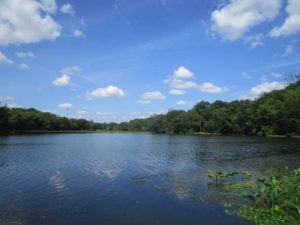
Etra Lake, in East Windsor, Mercer County, sits on the Inner Coastal Plain. Most, if not all, bodies of water on New Jersey’s Inner and Outer Coastal Plains, are human-made – in Etra Lake’s case by the damming of Rocky Brook. Rocky Brook is part of the Raritan River-Bay watershed. The damming of the lake appears to go back to the late 1700s to create a power source to run a grist mill. The name “Etra” actually is an acronym, “ETRA,” after a prominent resident, Edward Taylor Rosel Applegate, born in 1831 and died in 1915.
THE CUESTA: Of New Jersey’s four land regions, two are in the Jersey Midlands – the rolling terrain of the Piedmont and the generally flat Coastal Plain. The Coastal Plain can be broken down further – the Outer and Inner. What people may not realize is the Coastal Plains are divided by an on-again, off-again hill system – the cuesta. The cuesta essentially runs from Sandy Hook in the northeast to the Philadelphia area in the southwest. It can easily be traced on a map through place names, from northeast to southwest – Highlands, Atlantic Highlands, Crawford Hill (391 feet above sea level) and Telegraph Hill (360 feet) in Holmdel, Quail Hill (258 feet) in Manalapan, Backbone Hill Road (250 feet) in Millstone, all in Monmouth County; Arneys Mount (230 feet) in Springfield, Mount Holly (183 feet), and Mount Laurel (173 feet), all in Burlington County. The cuesta or cuestas may rise hundreds of feet around surrounding land; Crawford Hill, for example, is the highest point in Monmouth County and rises about 350 feet over surrounding lowlands. The cuesta formation was formed at the time of the late Cretaceous and early Tertiary ages, two periods of geologic time that met about 66-1/2 million years ago. It basically was formed by water runoff, eroding the surrounding land and leaving the cuesta. The cuesta remains because it is cemented together by ironstone.
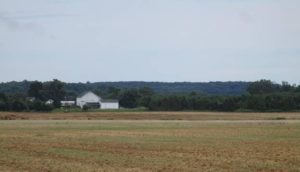
2017, August 6, Sunday — A view of the cuesta from the Union Transportation Trail in Upper Freehold, Monmouth County. The view is looking toward the Shore, so the abrupt rise in the terrain is seen. From the other side of the cuesta, the change in terrain is more gradual.
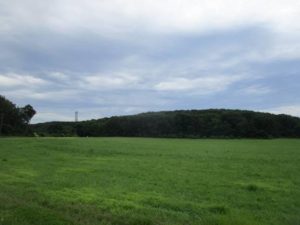 2017, August 6, Sunday — Another view of the cuesta – here, near the Horse Park of New Jersey in Upper Freehold, Monmouth County.
2017, August 6, Sunday — Another view of the cuesta – here, near the Horse Park of New Jersey in Upper Freehold, Monmouth County.

2016, January – Looking at the cuesta, about 200 feet above sea level, across Sandy Hook Bay from Sandy Hook.
BUTTERFLIES IN THE ZINNIA PATCH: Last year, my newspaper reporting travels took me to Bobby Laurino’s farm market in Colts Neck and Andy Capelli’s farm market in Middletown. I was amazed by the bees and butterflies attracted to their zinnia patches. Here was this abundance of pollinators and they were fun to watch. So, I did some research on zinnia – liking it because it is an annual, not a perennial I would be stuck with – and planted it in my garden, about 35 to 40 row feet. I wish I planted more! In recent days, I have spotted these butterflies: painted lady, “Vanessa cardui”; spicebush swallowtail, “Papilio troilus”; cabbage white, “Pieris rapae”; silver-spotted skipper, “Epargyreus clarus”; and monarch, “Danaus plexippus.” I try to become one with the zinnia patch, or at least letting the butterflies do their thing and me doing my thing, which allows me to get close to them and take great photographs.
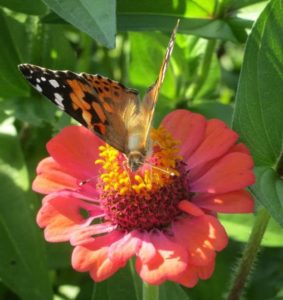
A painted lady butterfly in my zinnias.
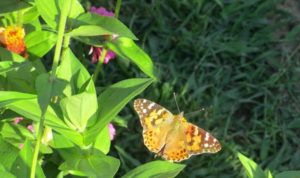
Painted lady in the zinnias.

Painted lady on a zinnia.
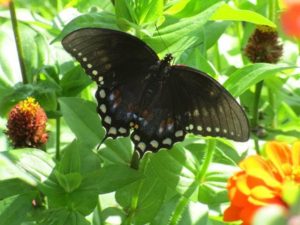
Spicebush swallowtail in the zinnias.
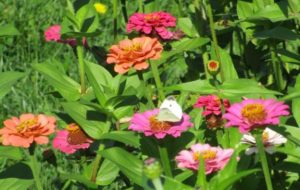 Cabbage white in the zinnias.
Cabbage white in the zinnias.
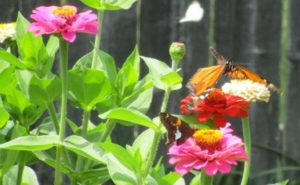
Silver-spotted skipper, lower, and monarch, upper, in the zinnias.
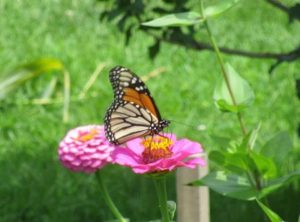
Monarch in the zinnias.
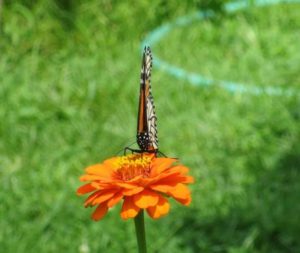
Monarch on a zinnia.
SOURCES, BUTTERFLIES: I love this Internet site of the North American Butterfly Association (NABA)-North Jersey Butterfly Club for identifying butterflies, http://www.naba.org/chapters/nabanj/butterflies.html.
GARDEN VOICE NO. 1, DEBBIE MANS: Debbie Mans reported, “We were just comparing notes at work on our gardens and we are all not seeing great results — split tomatoes, fizzled squash, slow on the tomatoes ripening, etc. This is in Monmouth County and Essex County. I am hearing more and more from others, too. You are not alone!” (Debbie is executive director and baykeeper for the New York-New Jersey Baykeeper environmental group based in Keyport, Monmouth County. Here is a profile I wrote of Debbie last year, http://tworivertimes.com/debbie-mans-midwesterner-with-jersey-sand-in-her-shoes/.)
NAVESINK RIVER BOAT RIDE: Debbie Mans’s New York-New Jersey Baykeeper group is sponsoring a Navesink River boat ride September 19, Tuesday, out of Atlantic Highlands, Monmouth County. Last year, I sailed with the Baykeeper on a Sunday afternoon on Raritan Bay and the Shrewsbury River – a great time! So, if free, consider the Navesink River ride. Monmouth County’s Navesink River, one of my favorite places in the Jersey Midlands as it flows along the cuesta emptying into the Shrewsbury River. For the Navesink River Sunset Eco Cruise.
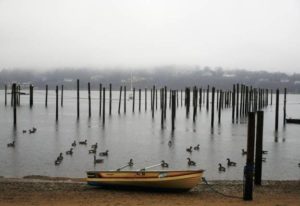
2015, December – Along the Navesink River.
GARDEN VOICE NO. 2, JACK MAHON: South Jersey gardener Jack Mahon and I recycle dehumidifier water, using it for gardening watering. But, this year, both Jack and I have noticed something – the heavy rains have left us with an overabundance of water. “The rain has been so heavy at times that the dehumidifier is way ahead of the trees’s need for water,” Jack said. Ditto. In recent days, my two barrels of water for the garden, totaling 50 gallons, have been full.
IN THE GARDEN AND YARD: I continued harvesting flowers, both zinnias and Knock Out roses, along with sweet corn. The fall crop is sprouting. And I watch the cucumbers and cantaloupe, hoping something comes about. The cantaloupes look OK as they grow, but the cucumbers seem to be victims of too much rain and I wonder if I will even get one to use.
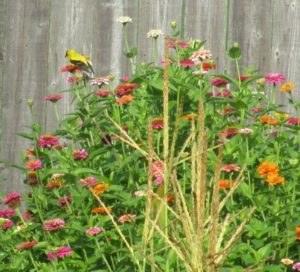
A male Eastern goldfinch, “Spinus tristis,” perched on a zinnia flower in the garden.
MONROE TOWNSHIP COMMUNITY GARDEN: I visited my lifelong hometown’s Community Garden and Park. It is a nice setting along the Millstone River. But I wish Monroe, which continues to develop heavily, would practice greener principles. For example, abandon magazine-photograph lawns and replace them with more productive organic gardens. Me, I am trying to go with as little lawn as possible – and my lawn is chemical-free. I know, I strive for an Old Monroe in a New Monroe whose population over its approximately 42 square miles is an estimated 45,000, a big difference from the estimated 5,000 when I was born in 1956.
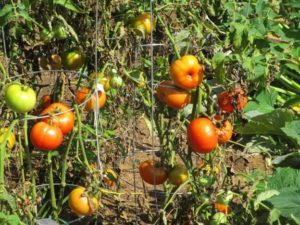
Tomatoes in the Monroe Community Garden and Park.
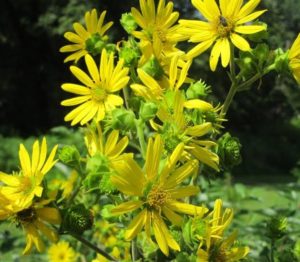
Flowers at the Monroe Community Garden and Park.
THE ECLIPSE OF THE SUN: On Monday, August 21, New Jersey will be treated to a partial solar eclipse. It begins at 1:22 p.m., peaks at 2:44 p.m., and ends at 4 p.m. DO NOT LOOK AT THE ECLIPSE UNLESS YOU HAVE SPECIAL PROTECTIVE EYEWEAR. (While I find the eclipse exciting, I do not want to take chances of looking up. So, I will take a nap, work in my cellar or garage, or follow the eclipse on the computer or television.) See https://eclipse2017.nasa.gov/.
CARDINAL PHOTO: The photo of a cardinal, “Cardinalis cardinalis,” in last week’s “Garden and Afield” drew a nice response from backyard neighbor Fran D’Aiello Rosuck. Fran and her husband, Ed, have been my family’s neighbor for about 40 years, or since about the time I went on my own after college. Then, after my parents, Joe Sapia Sr. and Sophie Onda Sapia, died, I, as an only child, moved back and took over the house. This summer, the outside of the house was remodeled. Fran said, “I always read that a cardinal is a visitor from Heaven. Your mom is probably saying the house never looked so good.” What a nice comment to find on my “The Jersey Midlands” page on Facebook.com.
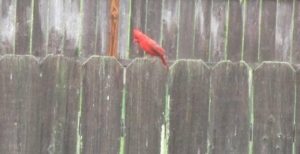
The cardinal at my garden. Actually, it is on backyard neighbor Fran D’Aiello Rosuck’s fence.
OCEAN TEMPERATURES: Atlantic Ocean temperatures on the New Jersey coast were in the range of about 75 to 77 degrees.
SUNRISE/SUNSET: For August 20, Sunday, to August 26, Saturday, the sun will rise about 6:15 to 6:20 a.m. and set about 7:40 to 7:50 p.m. For August 27, Sunday, to September 2, Saturday, the sun will rise about 6:20 to 6:25 a.m. and set about 7:30 p.m.
WEATHER: The National Weather Service forecasting station for the area is at http://www.weather.gov/phi/.
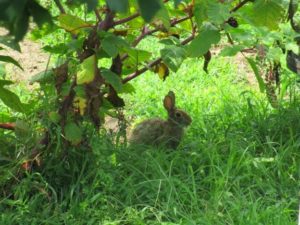 Rabbit, genus “Sylvilagus,” in the garden.
Rabbit, genus “Sylvilagus,” in the garden.
Joe Sapia, 60, is a lifelong Monroe resident. He is a Pine Barrens naturalist and an organic vegetable-fruit gardener. He gardens the same backyard plot as did his Italian-American father, Joe Sr., and his Polish-immigrant, maternal grandmother, Annie Poznanski Onda. Both are inspirations for his food gardening. Joe is active with the Rutgers University Master Gardeners/Middlesex County program. He draws inspiration on the Pine Barrens around Helmetta from his mother, Sophie Onda Sapia, who lived her whole life in these Pines, and his Grandma Annie. Joe’s work also is at @JosephSapia on Twitter.com, along with Facebook.com on the Jersey Midlands page.
Article and Photos by Michele Bakacs
Ahoy There Matey! Rutgers Environmental Stewards Take Their First Boat Trip on the Raritan River
On May 3rd the Middlesex class of Rutgers Environmental Stewards took the water. This afforded them a rare opportunity to see the Raritan River up close by taking a 2 hour boat trip on the new R/V Rutgers. The R/V Rutgers is a new boat operated by the Department of Marine and Coastal Sciences. This 36 ft. (11 meter) aluminum landing craft is a 20 passenger vessel and supports a wide range of educational and scientific needs such as trawling, grab sampling, diving, water profiling, coring, AUV operations, etc. Faculty can reserve the vessel so students can get a first-hand look at the Raritan River ecosystem and the human impacts to the watershed.
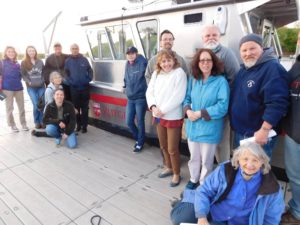
This is part of a larger effort by the Rutgers Collaborative for Research and Education to “Bring the River to your classroom” and works to support faculty efforts in engaging students and the community in Raritan River data and science through data activities.
The Rutgers Environmental Stewards program trains volunteers on important environmental issues affecting New Jersey and helps them make a difference in their own communities. The program consists of 60 hours of classes offered around the state on topics including habitat protection, climate change, geology, soil health, alternative energy, invasive plants, environmental policy, pollinators, and much more. Stewards complete a 60 hour internship of their choosing in order to become certified. Optional field trips are included. Anyone can become an Environmental Steward regardless of background.
The Stewards met the boat in Boyd Park in New Brunswick at the Class of 1914 Boathouse and were welcomed by the boat’s captain Chip Haldeman, and first mate Nicole Waite. Joining us on our trip was Dr. Heather Fenyk, Director of the Lower Raritan Watershed Partnership, and Dr. JeanMarie Hartman, Professor in the Department of Landscape Architecture. Heather and JeanMarie provided a rich history of the Raritan and identified points of interest including shale outcrop geologic formations, the Lenape Trail connection to the River, noted flora and fauna, as well as the industrial legacy of contaminated sites, old factories, and the Edgewater Landfill.
First mate Nicole taught the Stewards how researchers monitor water quality and trained them on collecting data using YSI water monitoring probes to test for dissolved oxygen, pH, temperature, and salinity. We also saw 2 Bald Eagles, countless Ospreys, Cormorants, and vast marshland. The salt marshes are mostly dominated by Phragmites australis, an invasive grass known as Common Reed, but we also saw native Spartina alterniflora (Salt Marsh Cordgrass) holding its own at the fringes of the saltmarshes.
Overwhelmingly the Stewards walked away with a new appreciation of this fantastic natural resource that most of us take for granted. Most people see the Raritan River as a place to avoid, to view from afar from the Garden State Parkway or Route 1 Bridge. This experience helped the Stewards better understand the River that lies in the heart of their community, and the importance of making sure it is cleaned up and protected.
Keep an eye on the LRWP blog for information about how to register for the Rutgers Environmental Steward class of 2018!
Drawing and article by Maya Fenyk (age 13)
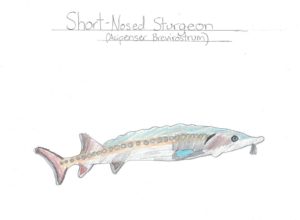
Short-Nosed Sturgeon
Hi! I’m Acipenser Brevirostrum, but you can call me Simon the Sturgeon. I am here to tell you about the many challenges I face as a two year old, juvenile short nosed sturgeon in the Raritan River. To start, I’d like to say how glad I am to be a sturgeon in 2017, even though my species has been federally endangered since 1973. Being a sturgeon living 120-150 years ago was even worse. Between the years 1870 and 1900, sturgeon were hunted for meat, but especially prized for their eggs for caviar.
We were nearly driven to extinction! Sturgeon are still feeling the effects 120 years later. Our population is only 12,000 in the waters New York and New Jersey, which truth be told is not a lot as female sturgeons lay 40,000 to 200,000 eggs per year. Caviar and hunting weren’t the only obstacle we have had to swim around to be able to survive. Another issue we face is river pollution. As bottom feeders we have a subterminal snout, we use our snout to vacuum our food from the substrate into our protractile mouth. This means that we pick up a lot of pollutants off of the substrate that isn’t food. We deserve to at least eat our meals of crustaceans, clams, mussels, snails, marine worms, flounder and plant matter, without having to guzzle down chemicals for dessert!
My species is considered a living fossil. We have been around for longer than 12,000 years and have retained a lot of primitive features that were common way back then, like our subterminal mouth and our barbels, a whisker like sensory organ. We have been in this area for longer than humans have, we have survived the caviar craze, and even industrial dumping that was common in Raritan for decades. That dumping residue along with the new stuff that has made its way to the Raritan (like expired medication, fertilizers and pesticides). These can turn into Endocrine System Disruptors (E.S.D) which damage our bodies and can either kill us or make us very sick. A lot of the pollutants also contain cadmium, arsenic are heavy metals that are extremely toxic.
Some ways you can help us live our natural life span of 35-70 years is by making sure to protect us from non-point source pollution. (That’s the pollution that is in stormwater runoff like pesticides, fertilizers, road salts and motor oil). You can make sure that streams have adequate buffers of plants and streams, and cleaning up our habitat will help. Also please let the NJDEP know if you see us. We are brown- gray fish with a yellow underbelly with a short rounded snout, heterocercal tail and a subterminal mouth, that is 18-22 inches long. Now I have to be going I see some yummy algae floating by. Though it isn’t fast food, but it sure moves pretty quick. Simon the sturgeon splashes out!
What is the most common type of litter in Boyd Park? Is there more paper or plastic in the grass? How many cigarette butts can you find? How many bottle caps? What is the most unusual item hiding in the bushes?
Join the LRWP and coLAB Arts on Sunday September 10, 10-noon for a River Health Workshop and “Scavenger Hunt” Clean-up of New Brunswick’s Boyd Park!
This event is coordinated in conjunction with the DIY MARKET at Rock New Brunswick. DIY Market is an open air marketplace that celebrates the creativity and spirit of the New Brunswick music scene. It is being held in Boyd Park, alongside a day-long homegrown New Brunswick music festival.

















































































